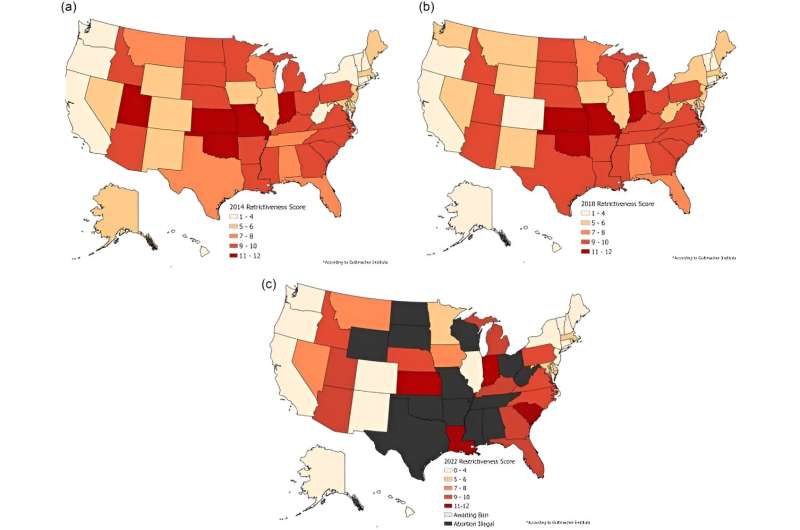This article has been reviewed according to Science X's editorial process and policies. Editors have highlighted the following attributes while ensuring the content's credibility:
fact-checked
peer-reviewed publication
trusted source
proofread
Higher infant mortality rates associated with restrictive abortion laws

Contrary to professed intent, the states where abortion access was most restricted experienced the highest levels of infant mortality in the United States from 2014–2018, according to recent research in the American Journal of Preventive Medicine. The findings showed that states with the most restrictive laws (11-12 laws) had a 16% increased infant mortality rate (IMR) compared to states with the least number of restrictive abortion laws (1-5 laws).
Lead investigator Lois K. Lee, MD, MPH, Division of Emergency Medicine, Boston Children's Hospital, and Departments of Pediatrics and Emergency Medicine, Harvard Medical School, explained, "As pediatricians and obstetricians, we are concerned about how threats to comprehensive reproductive care affect our patients and their infants."
"Given the current changing legal landscape in the US regarding reproductive health policy, it is essential that we consider the larger impacts of restricting access to abortion, not just to birthing individuals, but also on infant births."
In order to examine the association of abortion access not just on birthing individuals but also on infant births, the research team performed a national ecologic study using county-level birth cohort-linked files (linking maternal and infant data) on infant mortality from the National Center for Health Statistics for 2014–2018 (before the SCOTUS decision on Dobbs v. Jackson Women's Health Organization). While previous studies had primarily examined state-level infant mortality rates, these data are novel because of the more granular analysis of county-level infant mortality.
Investigators categorized 48 states (excluding Hawaii and Alaska) by the number of restrictive abortion laws and factored in driving distance to an abortion facility, key demographic characteristics, and state Medicaid expansion status.
In addition to the impact of restrictive abortion laws, demographic characteristics such as Black ethnicity of the birthing parent, high school education attainment or less, smoking during pregnancy, and inadequate prenatal care were associated with elevated IMR.
The investigators were surprised to find that increased driving distance to an abortion facility was not statistically associated with an increased county-level IMR, as had been determined by previous studies. This may be because prenatal care access is more of a contributor to infant mortality than abortion facility access.
The investigators stressed that if pregnant women with limited financial means have increasingly limited access to comprehensive reproductive health care, including contraception and pre-conception planning, the long-term health and well-being outcomes for these individuals and their children may affect future population health.
Dr. Lee elaborated, "Maternal health directly influences infant and child health—and ultimately population health. From our study findings, it is important to understand that limiting access to abortion as part of comprehensive reproductive care not only affects birthing individuals, but also their infants. Without the implementation of more equitable access to comprehensive reproductive care, there will be continued disparities in access to care and health outcomes, varying especially by geography in the US."
She added, "It will take years to truly understand the long-term public health impact of the SCOTUS decision on Dobbs v. Jackson Women's Health Organization and other challenges to comprehensive reproductive health care services. Given the well-established disparities in maternal and infant mortality by race and geography, we are concerned more restrictions on comprehensive reproductive care will exacerbate these disparities, especially among lower-income individuals."
More information: Kendall J. Burdick et al, Abortion Restrictiveness and Infant Mortality: An Ecologic Study, 2014-2018, American Journal of Preventive Medicine (2023). DOI: 10.1016/j.amepre.2023.10.010




















